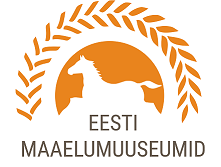2024 marks the year of Tartu as the European Capital of Culture, and we are delighted to announce that, as one of the main projects, we will open a joint exhibition of three museums on April 27th. This exhibition focuses on inventions and do-it-yourself (DIY) culture, which was particularly significant during the Soviet era, due to the circumstances of that time. Our museum's researcher Monika Levkin has written extensively about homemade machines, which can also be seen at the exhibition. The article was published on the AIMA website.
EPM TAe 94
This tractor was built by Kaino Kriit in the early 1990s. Kaino worked as a tractor driver himself, he could also weld, and as a technically talented man began trying to build a garden tractor. The frame and axles were acquired at minimal cost from his neighbours, then he added a more powerful engine and other necessary parts. The tractor is driven by a 1983 Mitsubishi Galant’s 1.6 litre engine and gearbox. Kaino built the towing coupling himself. This gardening tractor for a domestic vegetable patch was completed about 30 years ago. Later, his son used it for several years only for it to be ousted by more modern machinery.
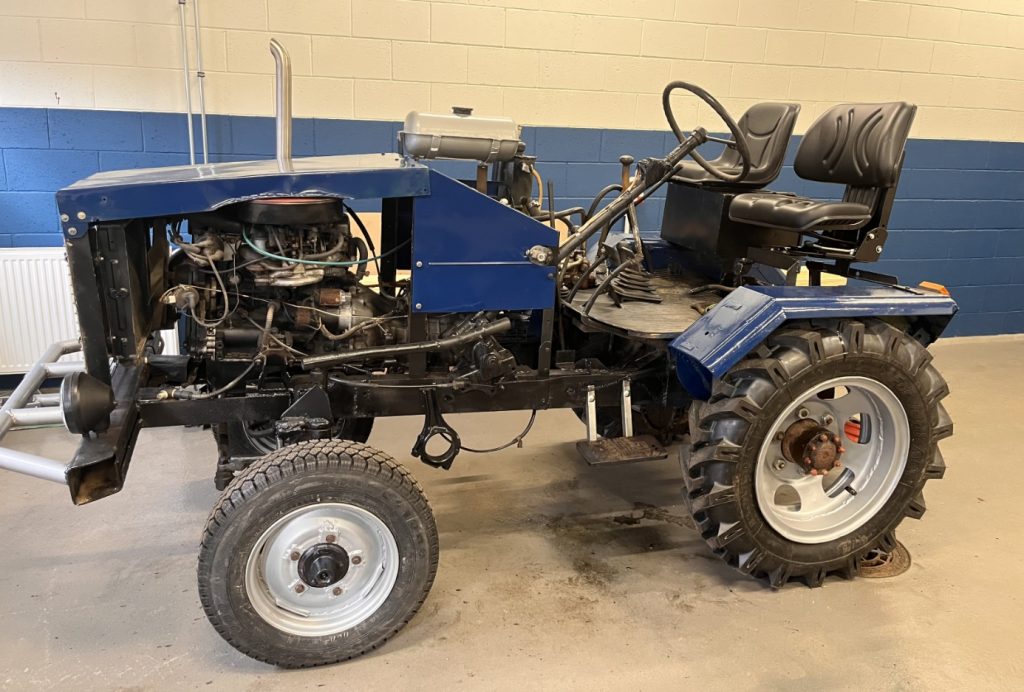
EPM TAe 94
EPM TR 2043 E 800
This tractor was built by Venda Luude in the middle of the 80s. It was used in his own household during Soviet times, and later at his farm until 2010. Venda built the tractor himself, only some parts were made by craftsmen according to his designs. Venda’s tractor had a rear axle and gearbox of an RS-09 tractor, with gears in reverse order. It also has a UDM engine located in the front. Rear reducers were made smaller and one cogwheel removed. Front wheels are from a T-25 tractor, as is the front axle. Venda welded the body frame himself; the mower is from an RS-09 and the rear wheels are the front wheels of a T-40 AM tractor. Ploughs, potato planter and hay maker could be used as attachments. This tractor was officially registered, as most of the fields worked were about 6 km away, so it was necessary to drive it on public roads. (Photo by Maarja Roosi)
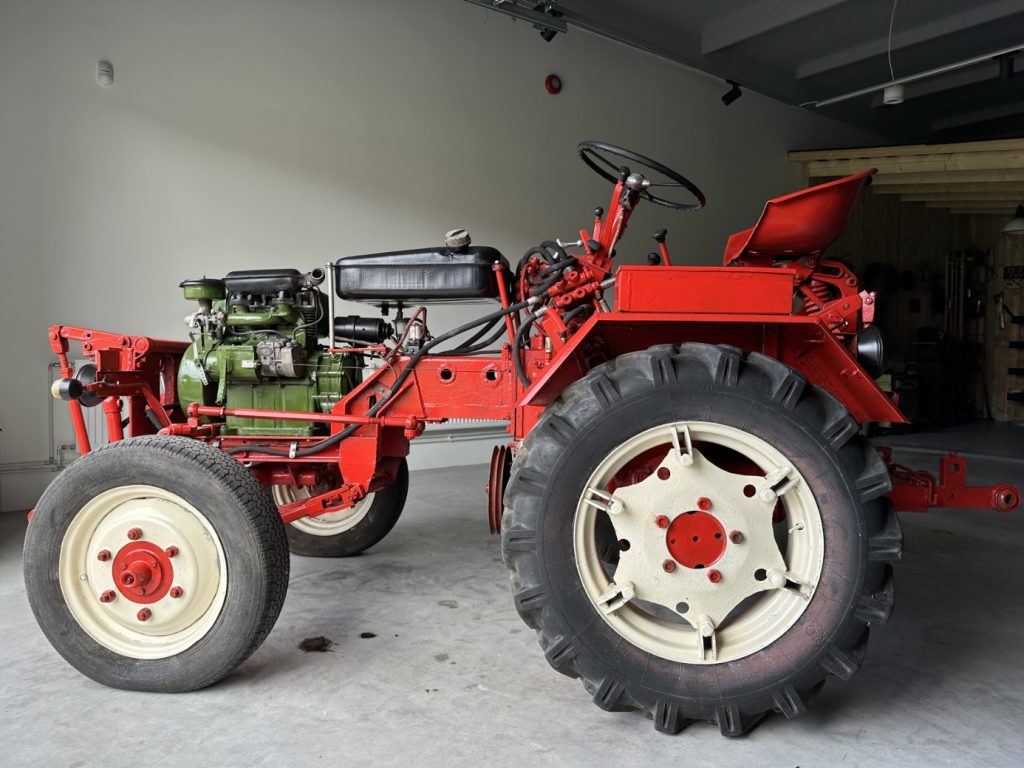
EPM TR 2043 E 800
EPM TR 2110 E 830
The creator of this 1980s tractor is Lembit Pint. A trailer with a watering tank, a plough, a harrow, and a tiller can be attached to this tractor. Lembit worked at a transport company while building this tractor, but the idea may have come from afar – from the well-established and well-known U.S. magazine Popular Mechanics. At the beginning, the tractor was hand cranked. It got a starter only around 2020. It was built to till potato fields. The trailer was initially bigger and was used to transport various objects. As it was not used very much, it was rebuilt into a smaller one and a watering tank installed. The watering tank’s pump is driven by the tractor’s shaft.
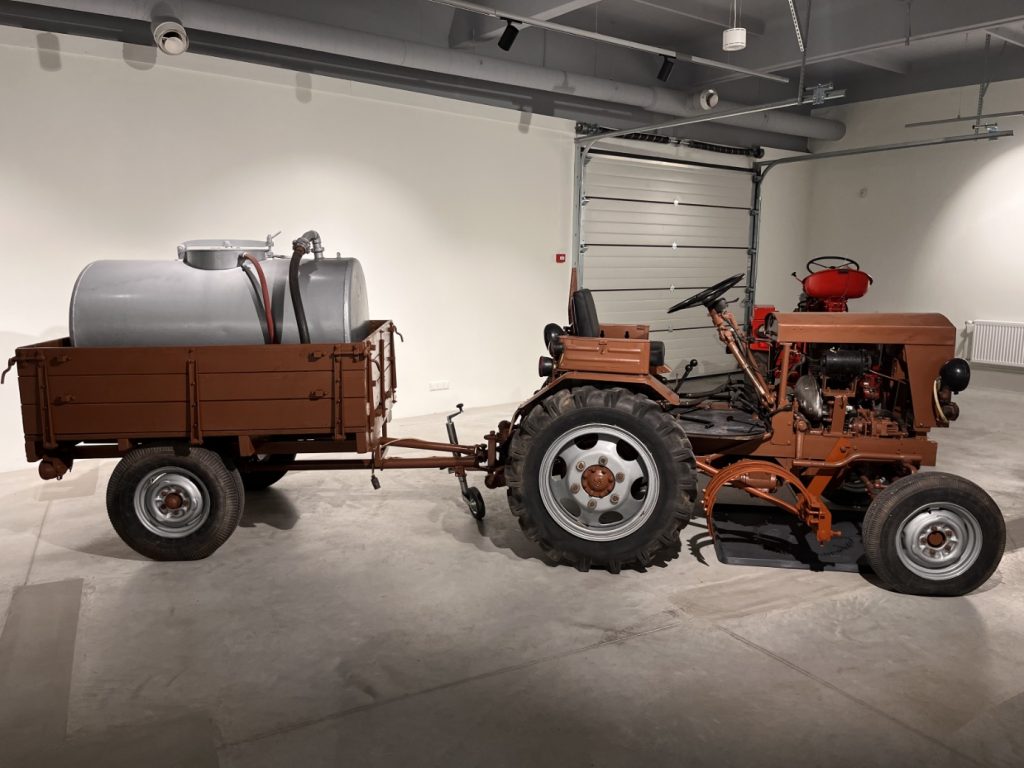
EPM TR 2110 E 830
Small equipment
During the Soviet era, every opportunity was used to alleviate the emptiness in the shops. In order to grow garden crops for one’s own use, sometimes backyard grass patches and the bases of fruit trees were cultivated in home gardens, not to mention cottage plots and the surroundings of apartment buildings. A tractor was not suitable for small garden beds, so simpler and more handy equipment was used here. In most cases, the appropriate “machine” was a mobile, sometimes motorized but often hand-pulled agricultural implement. Making it was also much easier and less expensive than building a tractor.
Soil cultivator, on loan from a private collection
The soil cultivator was built in 1970-1980 and used by the Roosve family. The basic structure is a women’s bicycle frame, which is turned upside down and has a plough welded to it instead of a saddle. The maker of the cultivator was said to have been a “modernizer” who also wanted to mount an engine to the frame.
The working principle of the device is simple – you had to both pull and push – it was convenient to use. The construction is light, even for a woman to use. When ploughing, the woman mostly went behind the plough and the man pulled from the front. When furrowing required more strength, then the man leaned onto the plough in the back and the woman pulled from the front. (Photo by Maarja Roosi)
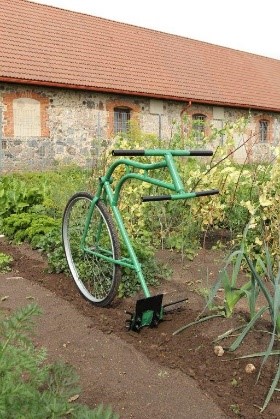
This tractor was built at Võru Public Service Company where there was a sort of serial production under way for these. It worked like this: a client brought along a blade of a horse-driven mower, the front wheels of an MTZ-53, the rear axle of a GAZ-51 truck, a gear changer and steering system, and a ZID engine. The Public Service Company manufactured the remaining metal parts, and the client was invited to receive his/her tractor on one fine day. This tractor was made on the same principle but as part of moonlighting somewhere at a craftsman’s home. Somehow it was legally registered and passed the technical inspection every spring. This tractor was in daily use for mowing grass and cultivating potatoes at Kooli Farm in Kastre Rural Municipality.
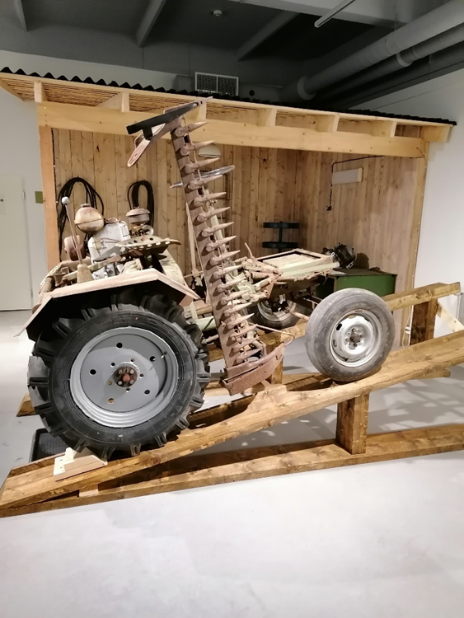
Historical Background
The Soviet occupation of Estonia, which began after World War II, destroyed the existing political and economic order. In rural areas, this meant forced collectivization from 1949 throughout the 1950s: farmsteads were destroyed; agricultural machinery, horses, and farm tools had to be taken to collective farms, even individual landholdings were merged. The land was nationalized. Each family was allowed to own up to 0.6 hectares, even though resources for cultivation were inadequate. In the newly created collective farms, people laboured hard for years, essentially without pay, seven days a week. Despite this, the collective farms remained extremely poor, farmers were kept alive by their personal household garden and one cow. They lived on the brink of starvation and in fear of Stalinist repressions.
After Stalin’s death in 1953, the political course of the USSR turned to the path of mitigation, and the previous repressions were condemned. The spirit of intellectual liberation, the so-called Thaw (1956-1964) and Khrushchev’s economic reforms brought significant changes to rural life as well. The agricultural reforms of the 1960s and the atmosphere of “normal life” created by the authorities stimulated the ability to take initiatives, adapting to the collective farm system. Most of the field work had been done using horses, now collective and state farms had the opportunity to acquire tractors. The purchase prices of agricultural products rose; the income of rural households increased. Unfortunately, the enthusiasm did not last long: economic progress was not at all reflected on local shop shelves – the dairy and meat products of Estonian “socialist” agriculture were mostly exported to other regions of the Soviet Union, so products from personal household gardens were needed to fill people’s dining table.
The arrival of tractors to the kolkhozes (collective farms) and sovkhozes (State farms) made it even more difficult to cultivate small personal garden plots: the machines were heavy and quite large, and most importantly, they could not be “borrowed” from collective farms whenever necessary. It was a general practice that the kolkhoz machinery was used to cultivate so-called private plots. Officially, or unofficially, the tractor driver was paid with a bottle of vodka – a well-known “currency” during the Soviet era. Even in the 1970s, horses were, on occasion, used for field work, but there was an obvious need for small tractors and suitable attachments.
The economic priority of the Soviet Union was the preferential development of heavy industry, whereas light industry and agriculture were secondary. The centralized economic system was too rigid for changes, so the idea of manufacturing small equipment never took off. In Estonia, several companies considered the production of small tractors, but it was not possible to start the process – it turned out that there were not enough suitable engines available. At the same time, the quality of the agricultural machinery that was already being produced was so low that mechanics often disassembled and rebuilt them on the spot. You could not get spare parts from factories, repairs took a long time, and a lot of equipment was simply written off and ended up lying around everywhere.
In this context, in the late 1960s, the construction of home-built small agricultural machines intensified. People had to be resourceful: “valuable gadgets” were acquired from scrapyards, junkyards and repair shops, and skilful men assembled the parts into a suitable tractor. People who made them were usually self-taught, but having a background as a locksmith or a welder was useful. They built the machines, but also had to be “inventors“: there were no guides or examples to be found. Some of the implements attached to the tractors were from pre-World War II and had been used in farms, but the more skilled “engineers” also made new ploughs, cultivators, furrowers, carts, mowers, snowploughs etc. themselves.
Local inventors and rationalizers gained legendary fame and the more enterprising also built machines to order. These homemade tractors were not officially registered, especially in remote rural areas, as they were not meant to be driven on public roads. The authorities generally did not forbid the construction of small-scale agricultural machinery, although the militia occasionally showed interest and there were instances of confiscation. The machines caused a lot of noise, vibrations, and even life-threatening situations, but it was possible to do the work in home garden plots: the small tractor was an important guarantee for the family’s survival. “It’s a good thing gasoline was practically free!” was a note usually added.
Today, some of this “mystical” technology can be found in a scrapyard, but for others the machine is a family relic, associated with nostalgic stories and warm memories. Several home-made tractors have reached the Estonian Agricultural Museum during collection campaigns.
Kaino Kriit, a tractor driver, recalls that during the Soviet era, there were small garden plots next to all apartment buildings in the countryside. He says, “Usually, one family had a patch about fifty meters long and ten to fifteen meters wide. There were a couple of rows of potatoes, a strawberry and cucumber bed, and a greenhouse tucked away in a corner. Sometimes a seating area was added.”
He continues, “When I worked as a tractor driver, during the day, I did the work for the collective farm, and in the evenings, I attached my plough and went to do extra work. I ploughed the entire village’s vegetable gardens at night, and nobody prohibited it. If you were willing to do it yourself and were ready to work at night, you could cultivate people’s lands with the collective farm’s tractor. If someone did that, it made things easier for the collective farm. And if something broke down… there was no problem at all.” Despite this, as a man interested in technology, Kaino also built himself a small tractor, because he needed it in the field and in the garden: “it’s yours, and you can plan the time for the work”.
COMING SOON
A new temporary exhibition “A Washing Machine Made of Beetroot: Resourcefulness in the Countryside” showcasing DIY culture during the Soviet era, including some incredible self-built tractors and gardening equipment, will be held from the 24th of April 2024 to September 2025 in the Estonian Agricultural Museum in Ülenurme as part of the European Capital of Culture Tartu 2024 main program. Come and take a closer look at these machines yourself!
Author: Monika Levkin, researcher at the Estonian Agricultural Museum.
